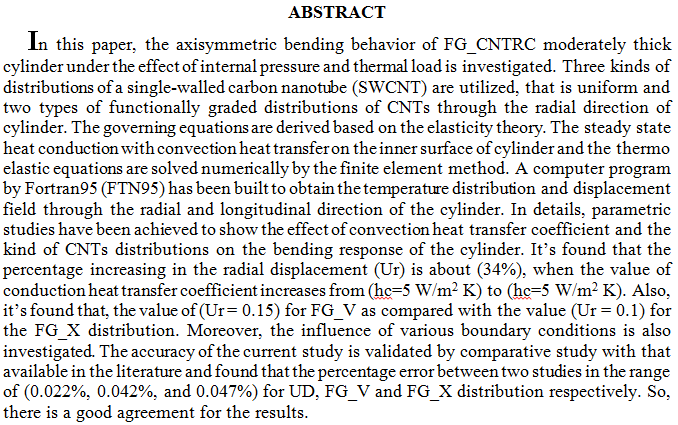
 (1)
(1)
 (4)
(4)
 (3)
(3)
Abstract
Robotics manipulators with structural flexibility provide an attractive alternative to rigid robotics manipulators for many of the new and evolving applications in robotics. In certain applications their use is unavoidable. The increased complexity in modeling and control of such manipulators is offset by desirable performance enhancements in some respects. In this paperthe single- link flexible robotics manipulator was designed and implemented from Perspex and designed with 0.5 m length , 0.02 m width and with 0.004 m thickness with mass located at the tip. There are four subsystems; motion, control, accelerometer and gyro and a host computer subsystem. The work principle of single-link robotics manipul
... Show MoreA nano manganese dioxide (MnO2) was electrodeposited galvanostatically onto a carbon fiber (CF) surface using the simple method of anodic electrodeposition. The composite electrode was characterized by field emission scanning electron microscopy (FESEM), and X-ray diffraction (XRD). Very few studies investigated the efficiency of this electrode for heavy metals removal, especially chromium. The electrosorption properties of the nano MnO2/CF electrode were examined by removing Cr(VI) ions from aqueous solutions. NaCl concentration, pH, and cell voltage were studied and optimized using the Box-Behnken design (BDD) to investigate their effects and interactions on the electrosorption process. The results showed that the
... Show More (16)
(16)
 (15)
(15)
This paper deals with finite element modeling of the ultimate load behavior of double skin composite (DSC) slabs. In a DSC slab, shear connectors in the form of nut bolt technique studs are used to transfer shear between the outer skin made of steel plates and the concrete core. The current study is based on finite element analysis using ANSYS Version 11 APDL release computer program. Experimental programmes were carried out by the others, two simply supported DSC beams were tested until failure under a concentrated load applied at the center. These test specimens were analyzed by the finite element method and the analyses have shown that these slabs displayed a high degree of flexural characteristics, ultimate strength,
... Show More (1)
(1)
Deep drawing process to produce square cup is very complex process due to a lot of process parameters which control on this process, therefore associated with it many of defects such as earing, wrinkling and fracture. Study of the effect of some process parameters to determine the values of these parameters which give the best result, the distributions for the thickness and depths of the cup were used to estimate the effect of the parameters on the cup numerically, in addition to experimental verification just to the conditions which give the best numerical predictions in order to reduce the time, efforts and costs for producing square cup with less defects experimentally is the aim of this study. The numerical analysis is used to study
... Show More (3)
(3)
This article presents the results of an experimental investigation of using carbon fiber–reinforced polymer sheets to enhance the behavior of reinforced concrete deep beams with large web openings in shear spans. A set of 18 specimens were fabricated and tested up to a failure to evaluate the structural performance in terms of cracking, deformation, and load-carrying capacity. All tested specimens were with 1500-mm length, 500-mm cross-sectional deep, and 150-mm wide. Parameters that studied were opening size, opening location, and the strengthening factor. Two deep beams were implemented as control specimens without opening and without strengthening. Eight deep beams were fabricated with openings but without strengthening, while
... Show More (23)
(23)
This article presents the results of an experimental investigation of using carbon fiber–reinforced polymer sheets to enhance the behavior of reinforced concrete deep beams with large web openings in shear spans. A set of 18 specimens were fabricated and tested up to a failure to evaluate the structural performance in terms of cracking, deformation, and load-carrying capacity. All tested specimens were with 1500-mm length, 500-mm cross-sectional deep, and 150-mm wide. Parameters that studied were opening size, opening location, and the strengthening factor. Two deep beams were implemented as control specimens without opening and without strengthening. Eight deep beams were fabricated with openings but without strengthening, while
... Show More (22)
(22)
 (23)
(23)
